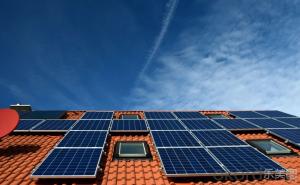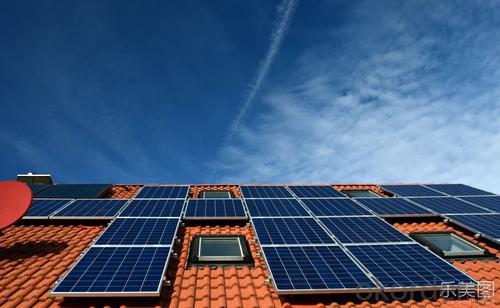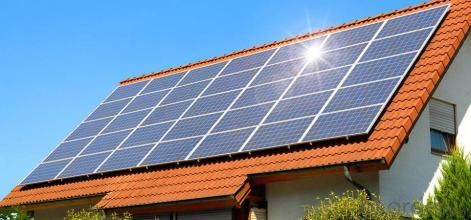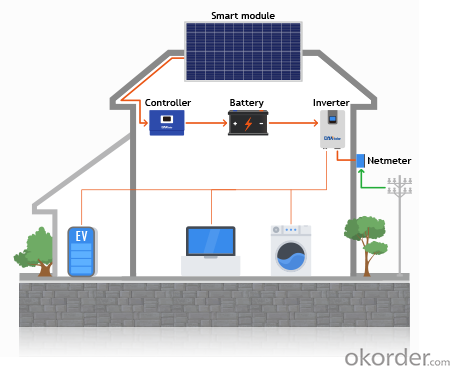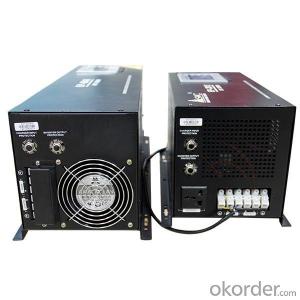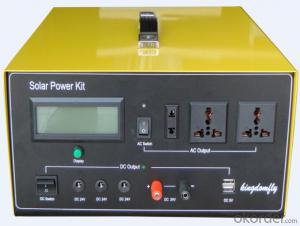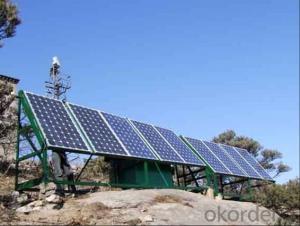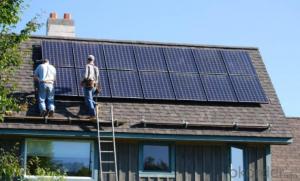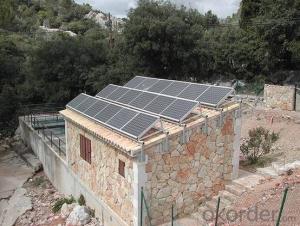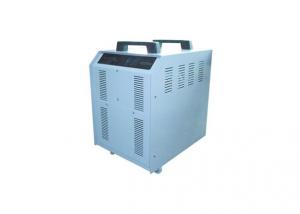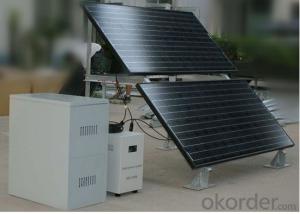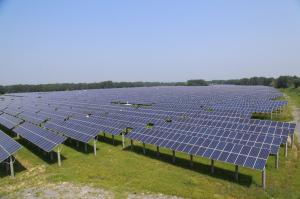10kw Solar Off-Grid Power System for Home - Solar Energy Systems Prices
- Loading Port:
- China main port
- Payment Terms:
- TT OR LC
- Min Order Qty:
- 1 set
- Supply Capability:
- 500 set/month
OKorder Service Pledge
OKorder Financial Service
You Might Also Like
Specification
1. Technical parameters of 10kw Solar off- grid Power System for home
- Solar panels
Power(Pmax): 320 Wp
Dimension: 1640x992x40 mm
Working Voltage(Voc): 39.7V
Working Current(Imp):9.32A
Weight: 20 kg
- PV Inverter with controller
Efficiency: >85%
Pure sine wave
AC 220V 50/60Hz output
Working Temp: 0℃~40℃
Battery overvoltage protection,undervoltage protection,overload protection,short circuit protection, overtemperature protection,etc.
580*290*675mm 77.5KG
-Mounting Bracket
Flat roof or Ground: Galvanized steel type;
Tile roof: Aluminium type
Wind Load Resistanc: 45m/s
Snow Load: 2kN/m2
- GEL Battery
12V180Ah
522*240*225mm 56KG
-DC Cables
PV1-F
TUV/UL certificates
2. Product images
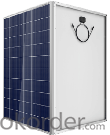
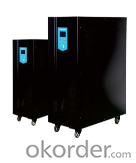



3. Product list
| No. | Item |
| 1 | Solar Panels |
| 2 | PV Inverter with controller built-in |
| 3 | Controller |
| 4 | Mounting racks |
| 5 | DC Cables |
| 6 | AC Cables |
| 7 | MC4 Connectors |
| 8 | GEL Battery |
| 9 | Combiner Box |
| 10 | Distribution box |
4. Remark
-In rainy days, the battery can support 2000W load work 24hours.
-The maximum power load should not exceed 8.5KW (including inductive load impact: such as refrigerators, air conditioners, washing machines, etc. with motor load).
-The battery can be fully charged in 5-6hours under STC sunshine condition.
- Q: How do solar energy systems impact national energy policy?
- Solar energy systems have a significant impact on national energy policy as they promote the transition to renewable energy sources, reduce greenhouse gas emissions, and enhance energy independence. By incentivizing the adoption of solar power through policies such as tax credits and feed-in tariffs, governments can diversify their energy mix, decrease reliance on fossil fuels, and achieve sustainability goals. Additionally, the growth of the solar industry creates job opportunities, stimulates economic growth, and fosters innovation in clean energy technologies. Overall, solar energy systems play a crucial role in shaping national energy policies towards a more sustainable and resilient future.
- Q: Can solar energy systems be used in powering beauty salons or spas?
- Certainly, beauty salons and spas can utilize solar energy systems to effectively power their establishments. Solar energy is a source of power that is both renewable and sustainable, enabling these establishments to decrease their reliance on traditional electricity and minimize their carbon footprint. Installation of solar panels on the rooftop or other suitable areas allows beauty salons and spas to generate their own electricity, resulting in long-term cost savings. Beauty salons and spas typically have high electricity requirements for operating various equipment such as hair dryers, hair straighteners, curling irons, lighting, and air conditioning. Solar energy systems are capable of meeting these power demands, particularly during daylight hours when the sun is shining. Any excess electricity generated during the day can be stored in batteries or directed back into the grid, ensuring a continuous and reliable power supply. Furthermore, by adopting solar power, beauty salons and spas can enhance their sustainability and environmental performance. This transition to solar energy enables these establishments to significantly reduce their carbon emissions and actively contribute to the global fight against climate change. Additionally, the use of solar energy can attract environmentally conscious customers who value businesses that prioritize sustainability. To summarize, solar energy systems present a viable solution for powering beauty salons and spas. They provide a dependable and sustainable source of electricity, while also offering cost savings and supporting greener and more environmentally friendly business practices.
- Q: Can solar energy systems be used in conjunction with energy storage systems?
- Yes, solar energy systems can be effectively used in conjunction with energy storage systems. Solar energy systems generate electricity during daylight hours, and any excess energy generated can be stored in energy storage systems such as batteries. These batteries can then be used to power homes or businesses during periods when solar energy generation is limited, such as at night or during cloudy weather. This combination of solar energy systems and energy storage systems allows for a more consistent and reliable supply of electricity, reducing dependence on the grid and promoting greater sustainability.
- Q: How does temperature affect the efficiency of solar panels?
- Temperature affects the efficiency of solar panels by causing a decrease in their overall performance. As the temperature rises, the efficiency of solar panels decreases due to the negative thermal coefficient of their photovoltaic cells. This means that as the temperature increases, the voltage output of the cells decreases, resulting in a reduction in the power generated by the panels.
- Q: Can solar energy systems be used in areas with limited government support?
- Yes, solar energy systems can be used in areas with limited government support. In fact, solar energy is a viable and sustainable option for regions that lack government incentives or financial aid. The decreasing costs of solar technology and the availability of off-grid systems make it feasible for individuals, communities, and businesses to adopt solar energy independently. Additionally, with the advancement of innovative financing models like community solar projects and microgrids, solar power can be accessible and affordable even in areas with limited government assistance.
- Q: Can solar energy systems be used for powering emergency backup systems?
- Yes, solar energy systems can be used to power emergency backup systems. Solar panels can generate electricity even during power outages, providing a reliable and sustainable source of energy for critical systems such as emergency lighting, communication devices, medical equipment, and more. By harnessing the power of the sun, solar energy systems offer a viable solution for ensuring continuous power supply during emergencies.
- Q: How does the angle of solar panels affect their performance?
- The angle of solar panels plays a crucial role in determining their performance and overall efficiency. The ideal angle at which solar panels should be positioned is dependent on various factors such as geographical location, time of year, and the specific application. When solar panels are angled correctly, they can capture the maximum amount of sunlight throughout the day. The angle primarily affects the amount of direct sunlight that hits the panels, which directly impacts their energy output. If the angle is too steep, the sunlight may not hit the panels directly, resulting in reduced energy production. On the other hand, if the angle is too shallow, the panels may not be able to capture as much sunlight as they could, leading to lower efficiency. In general, solar panels are typically installed at an angle that is equal to the latitude of the location. However, this may not always be the most optimal angle. For example, in regions with high levels of sunlight year-round, a slight tilt towards the equator could enhance the panels' performance. Additionally, seasonal adjustments may be necessary to account for the sun's position changing throughout the year. This can be achieved by either manually adjusting the angle or using solar tracking systems that automatically follow the sun's path. It is important to note that the performance of solar panels is not solely dependent on the angle. Other factors, such as shading, temperature, and the quality of the panels themselves, also influence their efficiency. Therefore, it is crucial to conduct a thorough analysis and consult with professionals to determine the optimal angle for solar panels, ensuring maximum energy production and return on investment.
- Q: How much energy can a solar energy system produce in a day?
- The amount of energy a solar energy system can produce in a day depends on various factors such as the size and efficiency of the system, weather conditions, and geographical location. On average, a well-designed solar energy system can produce around 4 to 6 kilowatt-hours (kWh) of electricity per kilowatt of installed capacity in a day.
- Q: Can solar energy systems be installed on flat roofs?
- Yes, solar energy systems can be installed on flat roofs. However, the installation process and design considerations may be different compared to pitched or sloped roofs.
- Q: Can solar energy systems be used for powering off-grid eco-lodges?
- Yes, solar energy systems can definitely be used for powering off-grid eco-lodges. Solar panels can be installed on the roofs of these lodges to capture sunlight and convert it into electricity. This renewable energy source can then power various electrical appliances, lighting, heating, and cooling systems within the lodges. By harnessing solar power, off-grid eco-lodges can operate sustainably and reduce their reliance on traditional grid electricity, leading to a more environmentally friendly and self-sufficient operation.
Send your message to us
10kw Solar Off-Grid Power System for Home - Solar Energy Systems Prices
- Loading Port:
- China main port
- Payment Terms:
- TT OR LC
- Min Order Qty:
- 1 set
- Supply Capability:
- 500 set/month
OKorder Service Pledge
OKorder Financial Service
Similar products
Hot products
Hot Searches
Related keywords
